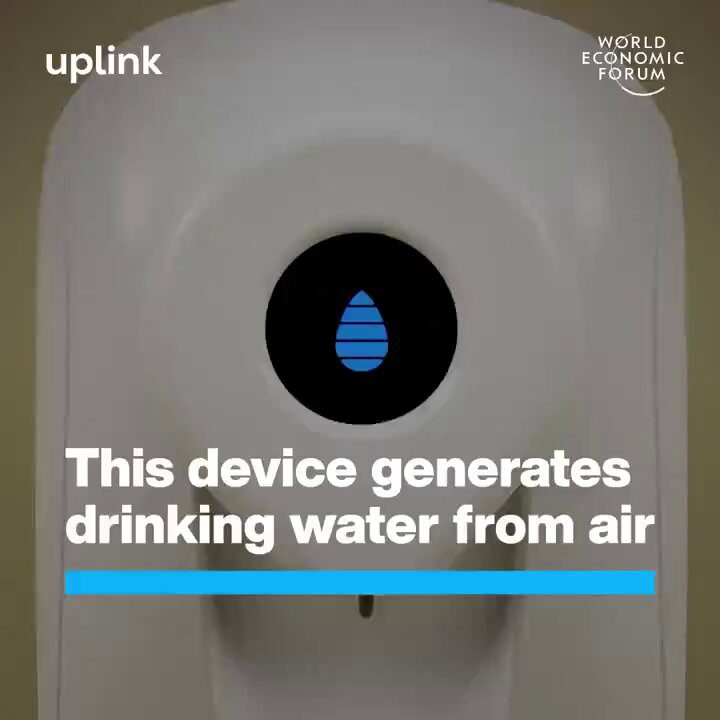In an era where water scarcity is becoming an increasingly pressing issue, innovative technologies are emerging to address this global challenge. One such groundbreaking innovation is a device that generates drinking water from the air. This technology, highlighted by the World Economic Forum (WEF), is a testament to the potential of #TechForGood, #Innovation, and #Technology.
The Technology Behind Water Harvesting from Air
The concept of generating water from air is not entirely new, but recent advancements have made it more efficient and accessible. The technology primarily revolves around the use of Metal-Organic Frameworks (MOFs). MOFs are a class of compounds consisting of metal ions coordinated to organic ligands to form one-, two-, or three-dimensional structures. These structures are highly porous and can capture water molecules from the air.
Atoco, an Irvine-based startup, is at the forefront of this innovation. They are developing a water harvester that uses MOFs to capture water molecules from the atmosphere. This device can generate potable water even in arid regions, making it a viable solution for areas facing severe water scarcity.
Competing Innovations in Atmospheric Water Harvesting
Atoco is not alone in this endeavor. Several other companies are also making strides in atmospheric water harvesting technologies. For instance, AirJoule, a joint venture between Montana Technologies and GE Verona, has developed a MOF atmospheric harvester that not only captures water but also provides energy-efficient air conditioning through evaporative cooling.
These innovations are driven by the rising demand for water solutions due to increasing water scarcity. The U.S. military has even established an Atmospheric Water Extraction program, highlighting the strategic importance of such technologies. In 2020, the Defense Advanced Research Projects Agency (DARPA) awarded a $14 million grant to General Electric to develop MOF technology that could supply water to troops.
Sustainability and Environmental Impact
One of the most significant advantages of using MOF technology for water harvesting is its sustainability. Atoco’s technology offers a sustainable solution to water scarcity by harvesting water from the air with no carbon footprint. This is crucial in the context of global efforts to combat climate change and reduce greenhouse gas emissions.
Moreover, this technology has the potential to revolutionize the way we address water scarcity, particularly in arid and impoverished regions. By providing a reliable source of clean drinking water, it can significantly improve the quality of life and health outcomes in these areas.
Broader Implications and Future Prospects
The implications of this technology extend beyond just providing drinking water from air. It can also be integrated into various applications, such as agriculture, where it can help in irrigation and improve crop yields. Additionally, it can be used in industrial processes that require large amounts of water, thereby reducing the strain on existing water resources.
The future prospects for atmospheric water harvesting technologies are promising. As the technology matures and becomes more cost-effective, it is likely to see widespread adoption. This will be further supported by government policies and initiatives aimed at promoting sustainable water management practices.
Related Innovations in Water Technology
The field of water technology is witnessing a surge in innovations aimed at addressing water scarcity and improving water quality. For instance, DrinkPrime, an Indian startup, offers IoT-powered water purifiers with customized filtration and AI-driven maintenance. Their affordable subscription-based service provides real-time monitoring and no additional fees for installation, maintenance, or relocation, making clean drinking water accessible to urban and rural households in India.
Similarly, INDRA, a cleantech startup, has developed an electro-chemical oxidation and coagulation process for wastewater treatment. Their plug-and-play solution requires 90% less space and achieves up to 99% water recovery, making it a highly efficient and sustainable option for industrial and sewage wastewater treatment.
Conclusion
The development of devices that generate drinking water from air represents a significant leap forward in addressing global water scarcity. As these technologies continue to evolve and improve, they hold the promise of providing sustainable and reliable water solutions for communities around the world. The integration of such innovations into broader water management strategies will be crucial in ensuring water security for future generations.
For more information on these technologies and related innovations, you can refer to the following sources:
- Startups Are Racing to Make Water Out of Thin Air
- DrinkPrime Makes Water Purifiers Tech-Smart & Pocket-Friendly
- UN Warns Against Thirsty Tech to Solve Water Crisis
- As Bengaluru Faces Severe Water Shortage, Anand Mahindra Shares Water-Saving Technique
- Business Accelerator The Circle FC Selects 10 Startups for Water-Tech Programme
- Does Hydrogen Water Live Up to the Hype?
- Opinion: Potable Water “”on-the-cheap”” in La Guajira, Colombia?
- Kilimo Helps Farmers Save Water and Get Paid for It
- As India’s Silicon Valley Runs Dry, This Bengaluru Doctor Has Some Water-Saving Tips You Can Use
- World Water Day: HCL Has Committed $15 Million Over Five Years to Bolster Entrepreneurs Focusing on Water-Related Solutions
- Hgen Draws on Lessons from Tesla and SpaceX to Drive Down the Cost of Hydrogen
- World Water Day 2024: Close the Tap Before It’s Dry
- Wase Zaps Microbes to Squeeze More Biogas from Wastewater Sludge
- Aepnus Wants to Create a Circular Economy for Key Battery Manufacturing Materials
- Cleantech Startup INDRA Raises $4 Mn to Offer B2B Water Purification Solutions
Check out more AI tools.
Elevate Guest Experience with RoomGenie
Textify Analytics – Affordable Insights at the Speed of AI
